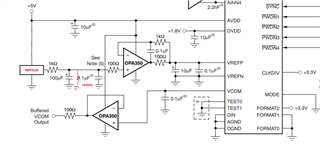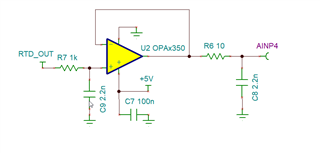Other Parts Discussed in Thread: OPA1632, OPA1633, OPA350, REF3325, OPA2350
Hi,
I have attached my current schematic for an ADS1174 circuit (based on the datasheet implementations) to acquire a single ended input signal with 0-2.9V range with my frequency of interest being 15kHz, but I have a few questions:
1. Is swapping the REF1004-2.5 (2.5 V reference) with a REF34-1.6 (1.6 V reference) the best way to change the FSR? Instead of (0-5V I want closer to 0-3V)
2. Is this interface also okay to use for the RTD or will it need a separate interface to read?
3. For these input interfaces should I change out the OPA1632 for OPA1633? It looks like the newer drop-in variant as OPA1632 is at end of life and might be more difficult to source soon.
Thank you!




